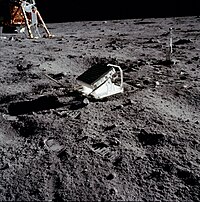
Photo from wikipedia
We study whether the optical properties of a solid glass retroreflector influence the value of the acceleration of gravity $g$ determined by dropping both solid and open retroreflectors in an… Click to show full abstract
We study whether the optical properties of a solid glass retroreflector influence the value of the acceleration of gravity $g$ determined by dropping both solid and open retroreflectors in an absolute ballistic gravimeter. The retroreflectors have equivalent optical centers and are dropped from the same height, at a fixed location, in the same gravimeter while recording time data corresponding to fixed fringe separation intervals of 400 fringes. The data for both types of retroreflectors are processed with commercial software, as well as with independently developed software based on a relativistic treatment of the phase difference between reference beam and test beams, and a realistic treatment of the effect of frequency modulation, with modulation index $\beta \gg 1$, on the interference signal. After applying corrections for polar motion, barometric admittance, tides, and ocean loading we find agreement between the values of $g$ determined with both types of retroreflectors, whether processed with commercial software or with our independently developed software. We suggest two procedures for computing relativistic corrections; the two methods agree to better than .01 $\mu$Gal.
Journal Title: Metrologia
Year Published: 2020
Link to full text (if available)
Share on Social Media: Sign Up to like & get
recommendations!